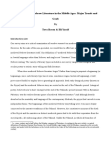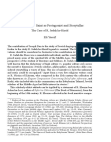"According to some Bön histories, it is said that the cult of goddess Sidpa Gyalmo as as Protector of Bön (Bön-skyong) was introduced by Shenchen Luga (gShen-chen klu-dga', 996-1035) from his Terma text discoveries at Dritsam Thakar ('Bri-mtshams mtha' dkar) in Tsang province in 1017.
Indeed, the red Sidpa Gyalmo does come from this Terma collection. [See the Srid-rgyal dre'u dmar-mo'i rgyud dang 'grel-pa bcas.] Be that as it may, Sidpa Gyalmo riding the black mule (dre'u nag) became the special Guardian for Yeru Wensakha Monastery established in Tsang province by the Dru (Bru) clan, and she remains so for its successor monastery of Menri (sMan-ri).
According to the textual sources, from out of the Dharmakaya Kuntu Zangmo (Bön-sku Kun tu bzang-mo) emanated the chief of the Matrika goddesses of the Bön tradition, Machok Sidpa Gyalmo (Ma-mchog Srid-pa'i rgyal-mo) "the Supreme Mother, the Queen of Existence."
At the Sambhogakaya level, Sidpa Gyalmo manifested in 5 aspects:
1. Yeshe Walmo (Ye-shes dbal-mo) as the universal aspect,
2. Khagying Lhamo (mKha'-'gying lha-mo) as the pacifying aspect (zhi-ba),
3. Duyum Lhamo (dus yum lha-mo) as the increasing aspect (rgyas-pa),
4. Kasang Lhamo (bKa' gsang lha-mo) as the enchantment aspect (dbang),
5. Dedro Sang-yum (bDe 'gro gsang yum) as the fierce or destructive aspect (drag-po).
Thereupon Sidpa Gyalmo emanated the various Dakinis attending her in her mandala.
- In the center of the mandala is Thugtrul Nagmo (Thugs sprul nag-mo) or Kali, who is directly emanated from the Mind (thugs sprul) of Sidpa
- Gyalmo.
- She has a single face and 2 arms and is riding upon a black mule.
- Therefore, she is called Dreu Nagmo (Dre'u nag-mo).
- Then she emanates the 4 medicine goddesses (rdzu-'phrul sman bzhi) and the 6 time goddesses (dus drug) who are the watch-keepers over
- the day, each watch being four hours.
- Then she emanates:
a.The 27 animal- and human-headed goddesses known as Walmo (dbal-mo nyer-bdun)
b.Beyond them the 4 door-keeper goddesses (sgo-ma bzhi)
c. The 9 female generals (dmag-dpon-ma dgu)
d. The the 12 Tenma goddesses (brtan-ma bcu-gnyis).
At the Bönpo monastery at Dolanji, in Himachal Pradesh, India, there is still performed a Cham or Lama dance called Srid-rgyal dus drug, devoted to representing these 6 time goddesses who are aspects of Sidpa Gyalmo.
Each of these goddesses has her particular watch of the day and has a different colour and attributes, as follows:
1. Sogchodma (Srog-gcod-ma), who is black in color, has the watch of the evening (srod),
2. Zhendebma (gZhen-'debs-ma), who is blue in color, has the watch of midnight (nam gung),
3. Wangdudma (dBang-sdud-ma), who is white in color, has the watch of daybreak (tho-rangs),
4. Odtroma ('Od-'phro-ma), who is yellow in color, has the watch of sun rise and early morning (nyi shar),
5. Trasalma (bKra-gsal-ma), who is red in color, has the watch of midday (nyin phyed), and
6. Zersalma (Zer-gsal-ma), who is purple-brown in color, has the watch of late afternoon and sunset (phyi 'phrod)."
Nota: Eu seu aspecto universal, sua manifestação como a Senhora Yeshe Walmo, ela é uma deidade à qual se deve pedir proteção em especial, seja para nós mesmos ou para nossos entes queridos, em tempos difíceis como os pelos quais estamos passando, i.e. de uma pandemia!



































